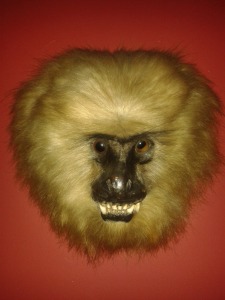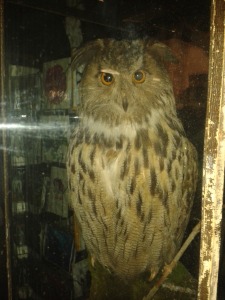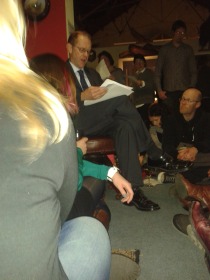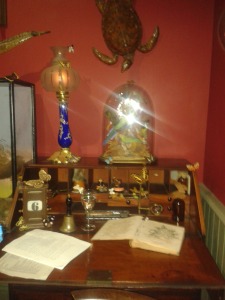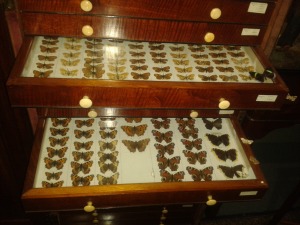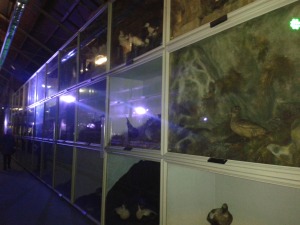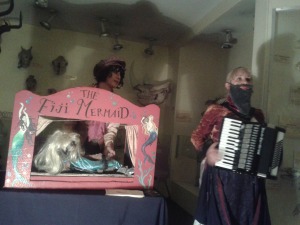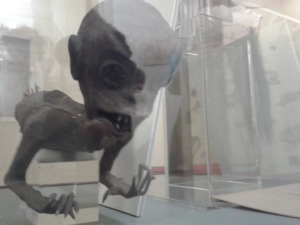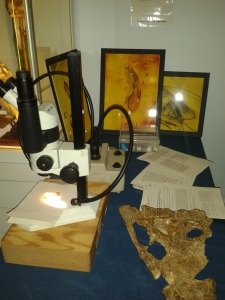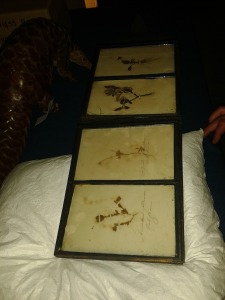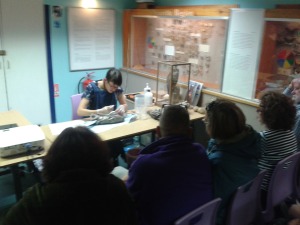The Booth Museum’s ‘Curious Night of the Slightly Strange’, offered guests the opportunity to explore one of Brighton’s best kept secrets. Off the beaten track on Dyke Road, the museum can be easily missed or misunderstood. Nadya, one of the Brighton and Hove museum workers on duty, said: ‘It’s amazing how many people have lived in Brighton and Hove all their life and never been here. One man told me tonight he thought it was a museum of toll booths.’ A far cry from a museum of toll booths, the museum houses a vast collection of Victorian taxidermy and takes its name from Edward Thomas Booth, who founded it in 1874. It is a macabre menagerie; the dead, glassy eyes of hundreds of birds and beasts stare balefully, almost accusingly out of their glass tombs, suspended forever between life and death. Nadya, summed up the atmosphere of the 140 year old museum neatly, saying: “You’re in another world here.”
Exhibits from the Booth Museum
Although the museum is the second largest natural history museum in the South East, it was the promise of the curious and slightly strange that drew people to its doors on November 7. It is the quirky spirit of the Booth which really makes it stand out from the crowd and it was this which the night encapsulated perfectly. Greeted at the door by the grimace of a giant brown bear, the guests were immediately plunged into the curious Victorian psyche of the museum, which revels in all things morbid, uncanny and sensational.
This macabre collection provided the perfect setting for a night full of the curious and slightly strange. For one night the museum was jolted from its deathly slumber and infused with a buzz of childish curiosity and eerie accordion music, as guests sipped wine and explored the eight events spread across the museum.
One highlight of the evening was run by the Booth Museum’s writer in residence, Michael Jackson, who is commissioned by Arts Council England with portraying the many wonders of the museum through his writing. Mr Jackson sought this commission, saying: ‘my interests are in eccentricities and Victoriana’, (two things which the museum certainly does not lack).
During the event Mr Jackson was fittingly ensconced in the crimson Victorian parlour, reading from his collection of short stories, Ten Sorry Tales. Enchanted, the eager crowd sat cross-legged on the floor listening to ‘The Lepidoctor’: a fittingly macabre story about beauty, death and regeneration. The story, (inspired by the exhibit of mounted butterflies), had soaked up the sinister undertones of the museum and subverted them, with life prevailing over ‘the killing net’ (‘The Lepidoctor’).
Michael Jackson reading ‘The Lepidoctor’ in the Booth Museum’s Victorian parlour.
Considering the eerie tableaus of life-in-death housed by the museum, this event was perfectly pitched; drawing out the morbid Victorian fascination with death, whilst also raising modern ethical concerns.
Butterfly Exhibition Glass cases: Booth’s taxidermy collection.
A short journey down a darkened, morgue-like corridor led guests into the world of the Victorian side show, evoking the spirit of Victorian sensationalism. The show was based on The Fiji Mermaid, a famous Victorian hoax perpetrated by Dr Griffin, (a phony naturalist), and P.T Barnum, (owner of the American Museum). Having obtained a gruesome creature, constructed from a fish’s tail and a monkey’s torso, they whipped the media into a frenzy, claiming Dr Griffin had discovered a mermaid in Fiji. This sort of deception was commonplace during the Victorian era, as foreign fishermen exploited the Victorian’s fondness for the peculiar. The museum has its own example of a ‘merman’, donated by Henry Willett in 1890. It was near this snarling ‘merman’ that Daisy Jordan’s ‘Barely Human Puppets’ performed their sideshow, taking on the mantel of penniless show-women trying to profit from the allure of the uncanny.
Daisy Jordan’s ‘Barely Human Puppets’ performing ‘The Fiji Mermaid’ (left). The Booth Museum’s ‘merman’ (right).
The theatricality and spectacle of the evening was balanced by a number of informative events. Those hungry for facts were able to join the museum’s curators, John Cooper and Lee Ismail, in ‘The Cabinet of Curiosities’. This was a show and tell session, in which the curators discussed some of the museum’s hidden treasures. Amongst these were plants brought back from early expeditions to the North Pole. Mr Cooper confessed: “We didn’t know we had them in our collections until recently! We have in our collections… …around 1 million specimens.”
Museum’s prized possessions (left) Plant specimens from the North Pole, 1826 (right).
Also on offer was a taxidermy demonstration by ethical taxidermist, Jazmine Miles-Long, who only works on animals that have died a natural death, and a behind the scenes tour of the museum’s vast storage facilities.
Cabinet of Curiosities (left) Jazmine Miles-Long (right)
Having completely sold out, many of the museum workers thought it likely the event would be followed by more of its kind. This evening of quirky delights may be over but it merely heralded the beginning of a series of late night events across Brighton and Hove museums. Although not yet published, it is well worth keeping an eye out for the upcoming events. This surreal Victorian evening showcased the delights of an often over-looked museum, who knows what Brighton secret may be revealed in the next event.
